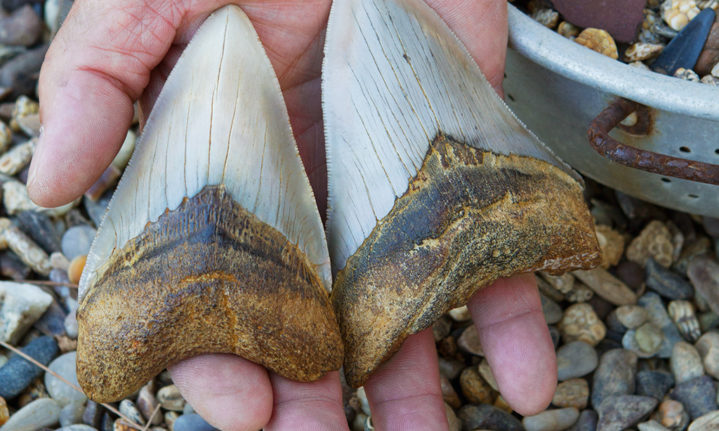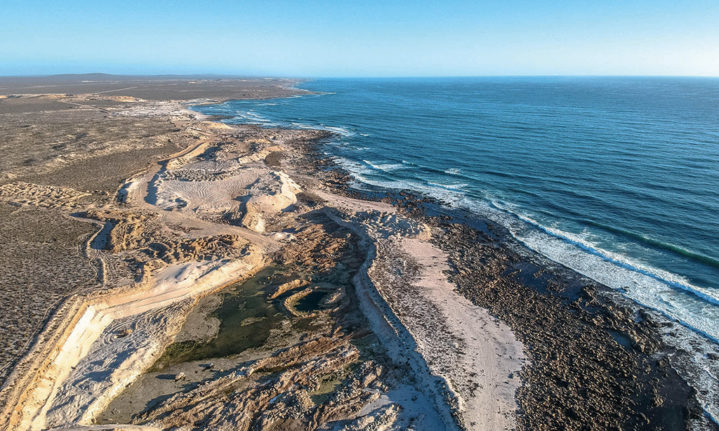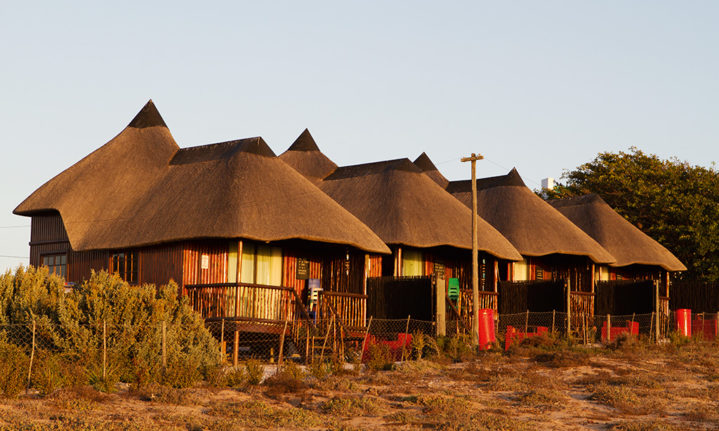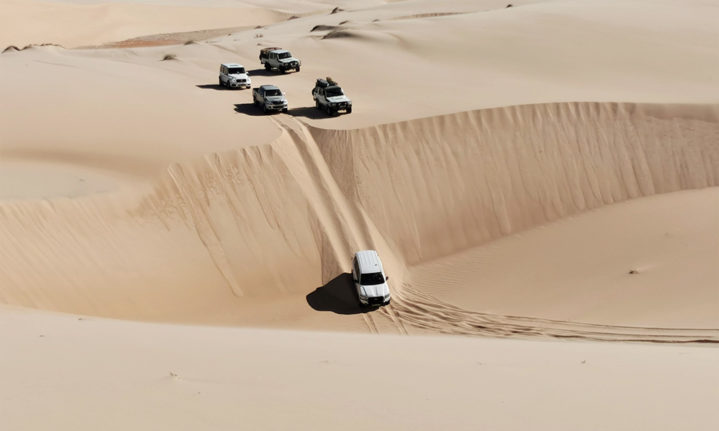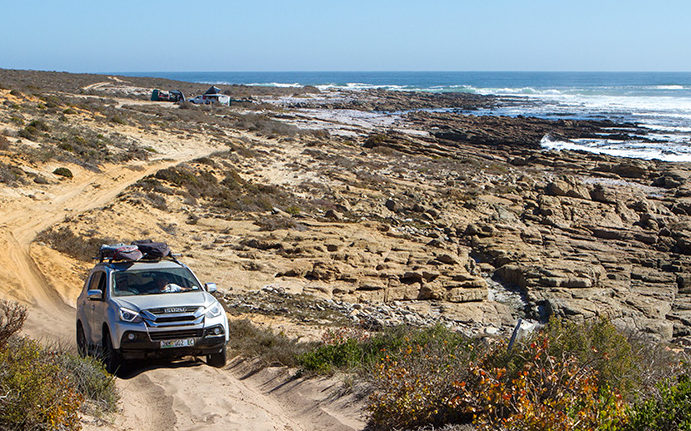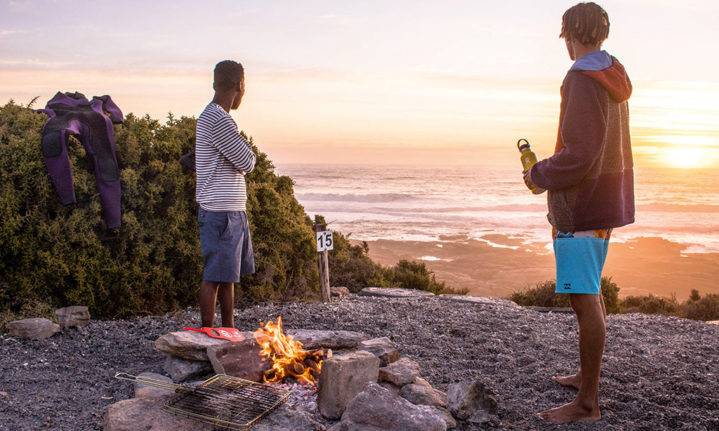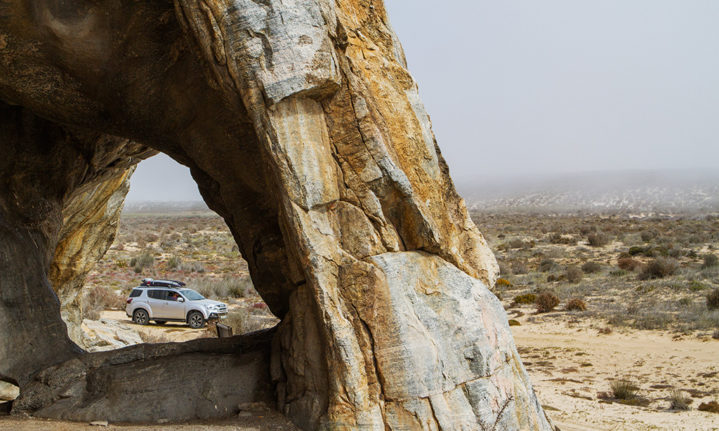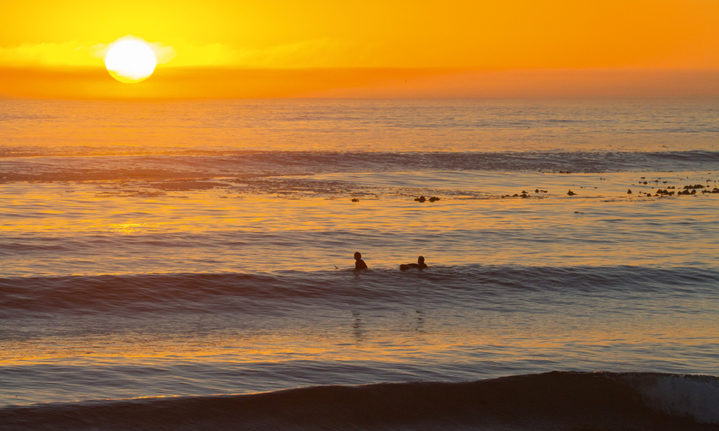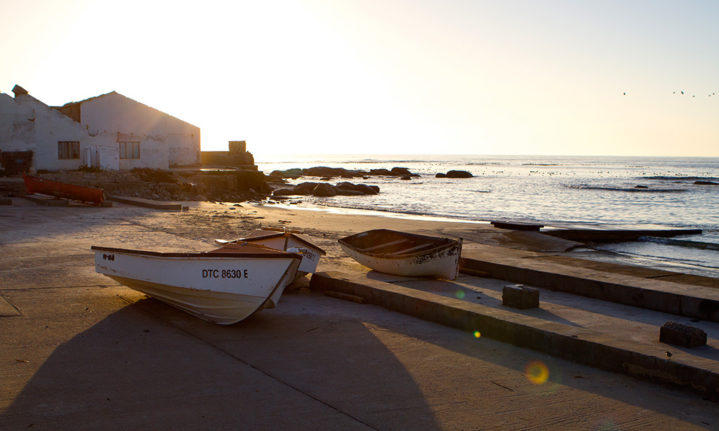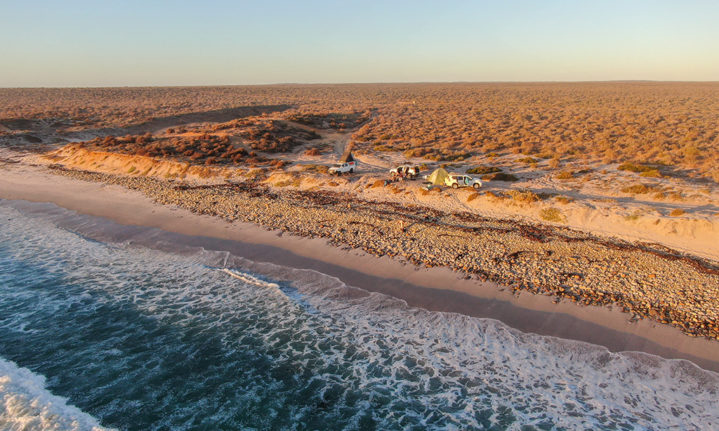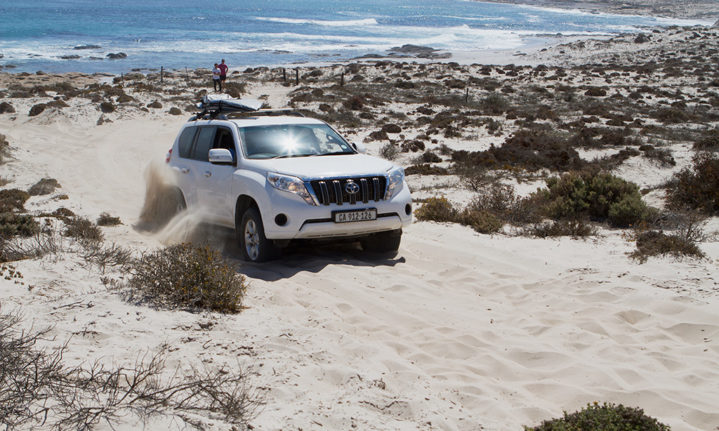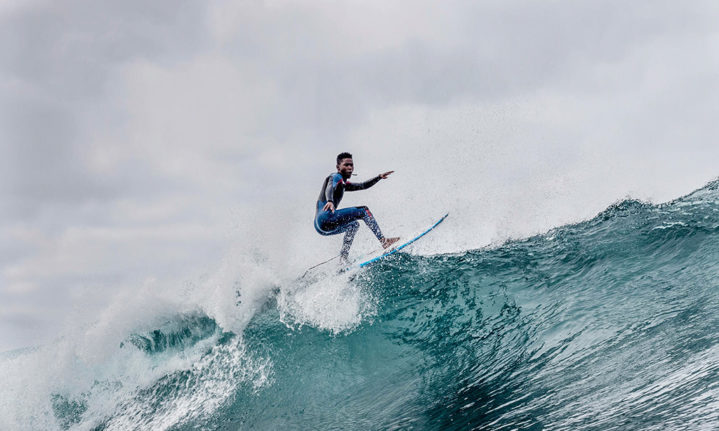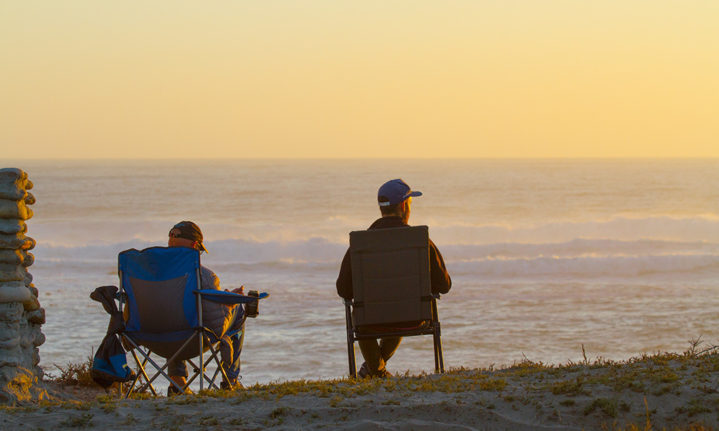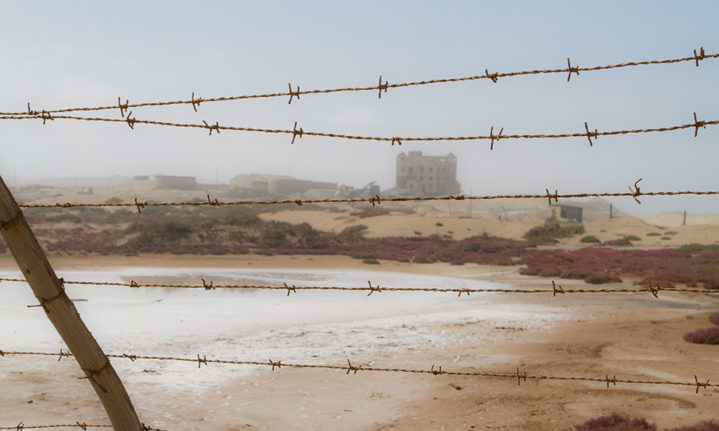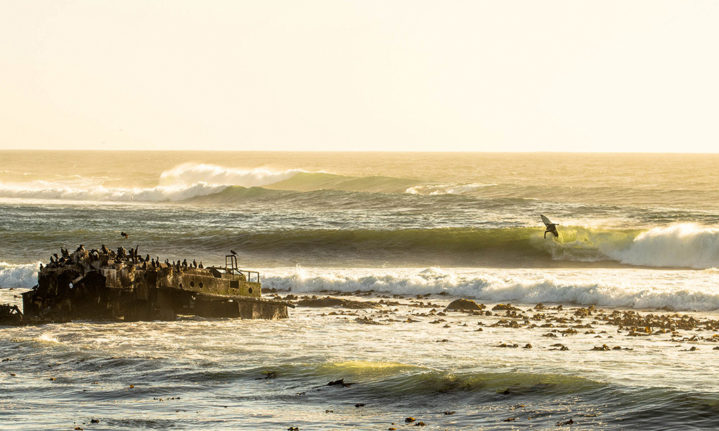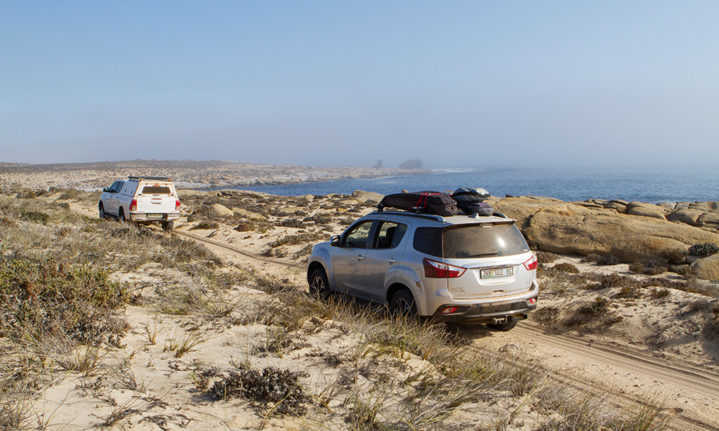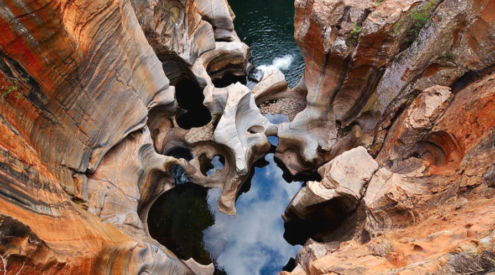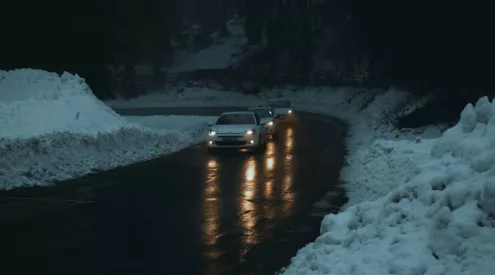The Cape West Coast is a place of fantastical gems, soupy fog, ethereal springtime blooms and world-class surf, bordered by one of the few coastal strips worldwide where you can wild camp at will. But, for how much longer?
Words & Photos: Catherine Hofmeyr

From big hollow slabs to sublime sunset moments, the West Coast rewards surfers and campers who live for ‘the search’.
It was a photo that inspired the trip. A photo in an international surfing magazine of a scraggly bush with a peg number 15 in the foreground, and a grinding right barrel peeling off in the background. The caption indicated simply that it was somewhere on the West Coast of South Africa. Sebastian had the photo on his phone and he was on a mission to find ‘Camp 15’. Alexander Bay, at the mouth of the Orange River, seemed the obvious place to start looking.
I’d always wanted to drive from the north-western tip of South Africa, slowly southwards as close to the sea as the sandy tweespoor and mining concessions would allow. When the guys from Amandla Surf Foundation returned late last year from a three-week recce trip with reports of waves, but also of rampant mining expansion, I felt it was time to go see for myself. Sebastian Lanz, some old-time Weskus surfers and frothing 4×4 adventurers were only too keen to join me.
An old acquaintance, Gavin Craythorne has been a diamond diver along this coast for 35-odd years, and he kindly offered to give us the rundown of Alexander Bay.

The rusting remains of the Piratiny loom out of the sea mist – she’s one of three prominent wrecks you’ll encounter on the 4×4 Shipwreck Trail.
Alex, particularly with a rising full moon, resembled a post-Apocalyptic setting from a Deon Meyer novel. On the beach, metal-laden deposits lent the sand a dark hue and the flooding Orange River clouded the unruly sea with brown silt. An abandoned mining plant was sequestered behind rusting barbed wire, while old coffer dams scarred the sand. ‘If someone doesn’t stop this soon, the whole coastline will look like this,’ Gavin said, pointing to slate ‘walls’ as far as the eye could see.
Beyond lay a wild, hauntingly beautiful, mostly unpeopled, but mineral and gem-laden coastline… and waves.
Re-invented Towns and Rusting Shipwrecks
In a white-out fog, the once bustling mining enclave of Kleinzee, had ‘ghost town’ written all over it. But a stop at the fascinating Kleinzee Museum – and meeting the good folk there – soon dispelled this notion. Around 2013, when the ‘last’ diamond was collected, De Beers pulled out and sold off its assets. A cracked salt pan, jetty and derelict clubhouse bear parched testimony to the regattas once sailed on a man-made lagoon at Kleinzee Yacht Club. But the town now has 11 guesthouses, I learnt from Jeanene Jessnitz and tourism officer Herman de Vries who are championing the area as part of the Namaqualand Coastal Route initiative to help rural communities get on the tourism map.
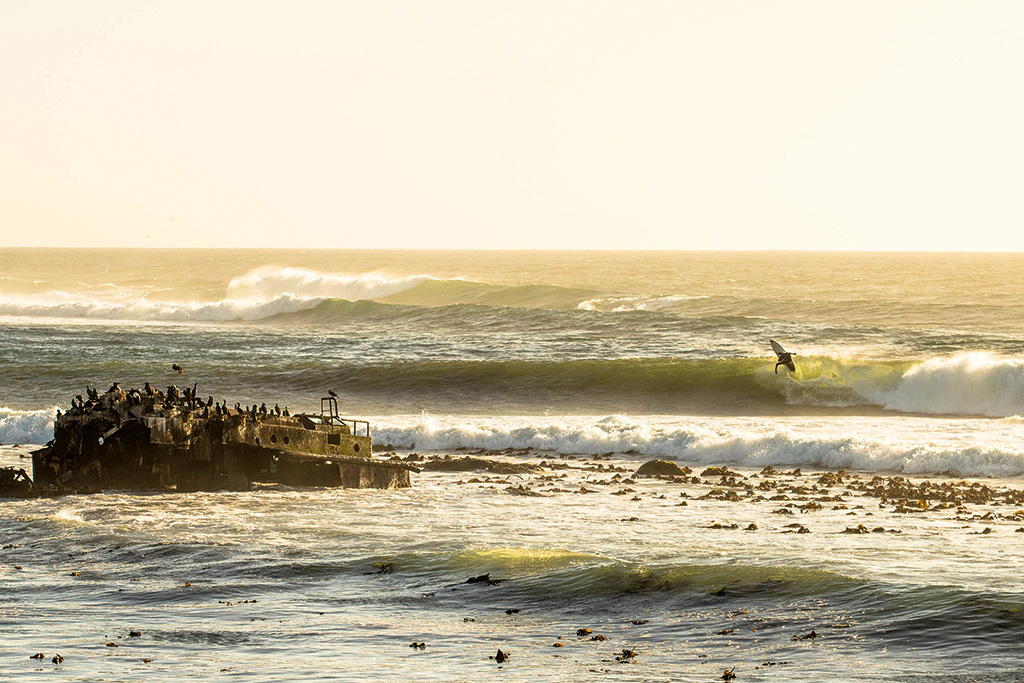
Joshe Faulker gets to work on his backhand at Hondeklipbaai, while cormorants on the wreck of the Jahleel diamond boat applaud. (Photo Ian Thurtell)
When Herman produced a handful of campsite marker pegs with numbers on them, we thought we’d hit Camp 15 paydirt. On what was once a De Beers game farm south of the town, there’s wild camping on an unmined strip of magnificent coastline. Pay your fee, pick a number at the museum, then go find your perfect camp spot. A careful recce of the bays revealed lots of potential surf points, but the swell was tiny and Herman’s No 15 marker didn’t quite match the one in the photo.
We headed instead to Die Houthoop, a guest and working farm where MP Veronica van Dyk has worked quirky décor marvels with rusted bric a brac and the dinner of seafood and farm fare was a feast.
Next morning we set off for the much anticipated Shipwreck Trail, a guided only route that hugs the dunes and spectacular bays for around 37km, from near Kleinzee to outside Koingnaas – and, if the talk was accurate, promised some of the best surf spots on the Namaqualand coast.

There’s good fishing off the beach at Alexander Bay but an abandoned mining plant lends the place a portentous air.
‘Right, here comes your first sand test. Deflate tyres to 1.2 bar and turn off the traction control,’ instructed renowned Namaqualand guide and 4×4 expert, Dudley Wessels. We were at Samson’s Bak at the start of the trail. And, other than the drought-blackened vaal vygies (grey mesemb) of this succulent Karoo biome, we couldn’t see five metres in the fog. It’s the sudden arrival of this all-blanketing sea mist that’s partly responsible for the rusting hulks of ships dotting this strip of wave-battered coastline.
When the fog lifted a little, true to form Samson’s Bak showed its signature right-peeling point break. Glassy, perfect – and 5cm high! Dudley rubbed salt into our wounds by showing us pics of Samson’s Bak firing a few months earlier.
As we meandered the sand trails, Dudley kept in contact with our four-vehicle convoy by two-way radios, sharing tragic tales, identifying plants, including the tyre-piercing bossiecus papwielicus! and pointed out the Cape lark’s mating ritual. We found a small left break near the rusting ribs of the Border and the guys paddled out, soon enveloped in the fog.
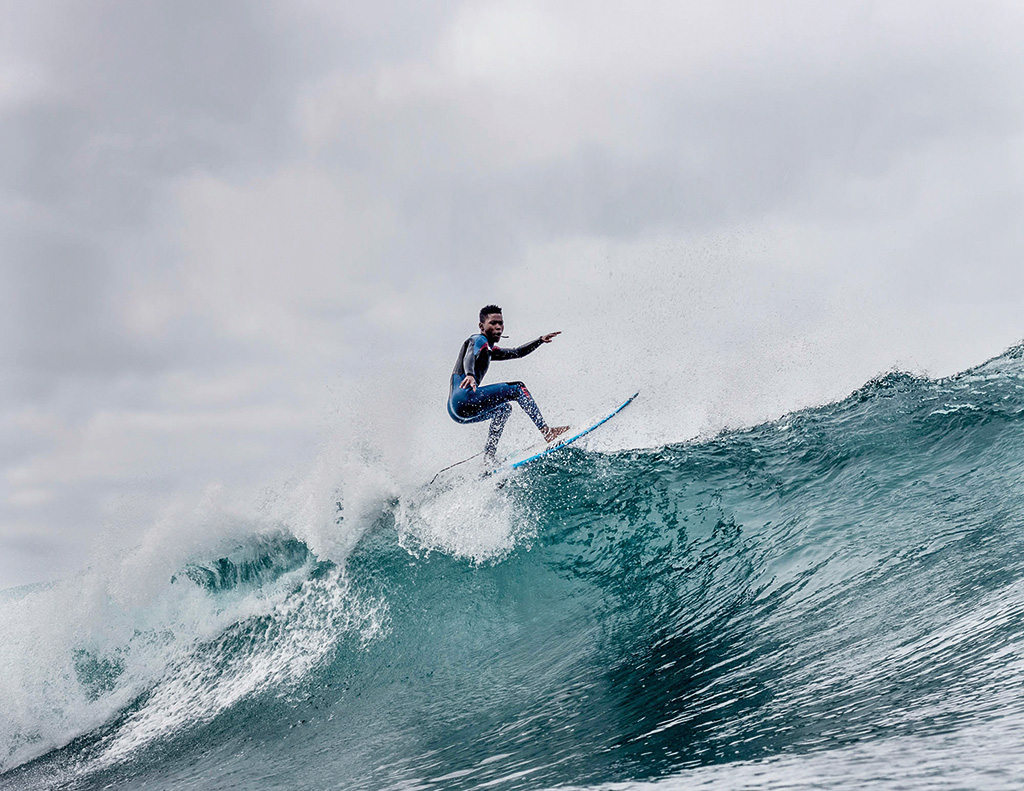
(Photo Ian Thurtell)
There’s a Zulu on my wave
Simo Mkhize, from the balmy waters of KZN, looking right at home on an icy West Coast bomb during an Amandla Surf Foundation recce trip up the West Coast last year. Find out more about how Amandla is helping and training SA’s future surfing stars at amandlasurffoundation.com
Even without swell, the Shipwreck Trail is high on action – and lovely lunch spots. Dudley’s expertise and his philosophy of ‘better to do it over than to overdo it’ got us up some challenging tracks, with many lessons learnt. Nearing the end of the day-long adventure, Dudley rung off the names of surf spots – that at the right tide and swell are world class: ‘Workshop, Trailer Bay…’ the kelp barely stirred.
At nearby Noup, the restored diver’s cottages were not yet operational but have since been opened again, giving surfers access to some nearby gated spots. Seb put Noup on his itinerary for the next winter swell, as we headed to Hondeklipbaai.
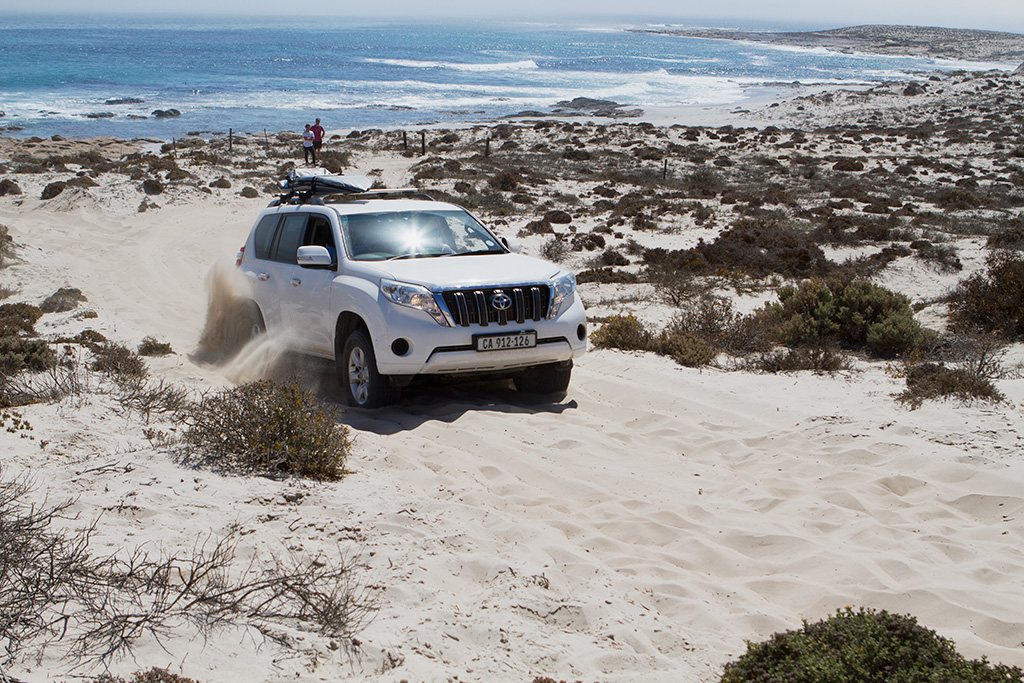
Some sections of the stunning Shipwreck Trail needed a bit of put-foot power – and occassionally the help of a snatch strap.
Such is the consistency of the waves at Hondeklipbaai that it has been scheduled for an international surf competition later this year. But for us, the sunset reflecting off a mirror sea was our welcome to the village, named after a rock that supposedly looks like a dog. It’s another place that’s reinventing itself from a mining and fishing past to tourism, but is plagued by regular water outages, joblessness and, in our case, extreme wavelessness.
We pulled into the lovely Honne-Pondokkies where Kempton Park attorneys (before lockdown) Emdi Swanepoel and her husband have combined her love of the bushveld with his love of the sea to fashion their erstwhile holiday home into a ‘surf and turf’ – thatched lodge-style pondokkies with a view over the main surf break – which wasn’t, er, breaking.
It’s wild, but you can drive it. The Namaqualand National Park, world-renowned for its neon spring flower show, has gloriously wild campsites dotted along the rugged coast. Boulderbaai found us searching for a small number 15 peg in impenetrable fog. We didn’t find it – or even the boulder or baai the campsite is named after.
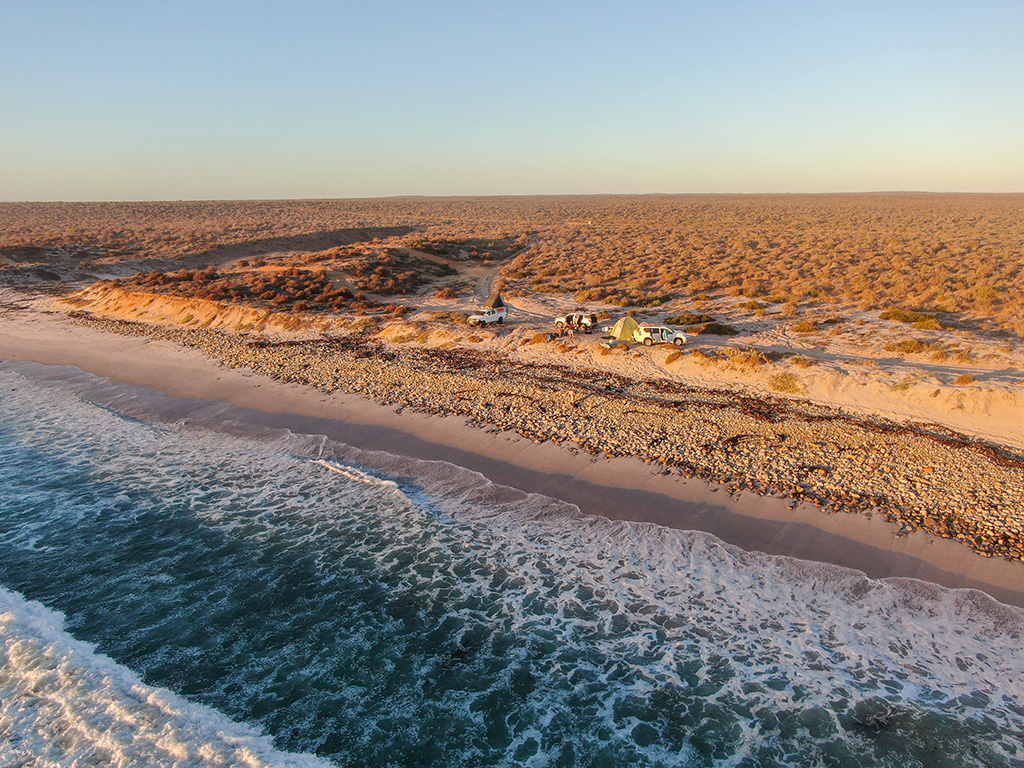
If you can do without flush loos and hot showers, this is the reward that awaits self-sufficient campers on the wild West Coast. (Photo Brandon Payne)
We did however find Spoegrivier Caves, where archaeologists have unearthed 2 000-year-old sheep bones – possibly the first evidence of domestic animals kept by the Khoi. At Skuinsklip we saw where Olympic boxer turned Nazi operator, Robey Leibbrandt landed off the yacht Kylo in 1941, on his nefarious mission to overthrow the Smuts government. And when the fog finally lifted at Kwass se Baai, the ocean had gone from zero to 10 foot overnight. Desperate, Sebastian paddled out – and was last seen being sucked out towards Rio (but returned bedraggled and exhausted an hour later having not ridden a wave).
When we showed Dudley the Camp 15 photo, he recalled seeing numbered camps south of the park. So the search ramped up after Groenrivier park gate. Many sand-sucking detours later, we spotted the first numbers, followed them in reverse order and Bingo! ‘Where is it,’ I hear all you surfers ask? Well, it’s right between Camp 14 and Camp 16. ‘Seek and ye shall find,’ is the mantra for West Coast surf missions.
Conditions were gnarly and the campsite exposed but we found a sheltered beach further on that Johnny pronounced to be ‘Long Beach without the crowds’. Up went the tents, out came the beers, and for the next two days we traded waves with a resident pod of dolphins.

Hondeklipbaai is a quirky weskus village with great fish and chips; soft evening light belies the vandalism that has destroyed the once-thriving fish factory.
Reality hit rudely once again after Brand se Baai as the meandering sand track morphed into a hard-packed dirt highway. I ramped off the road in fright as a huge truck thundered past in a cloud of dust, with inches to spare. Incongruous on the white beach, more yellow trucks wait; a pipe spews gravel onto a mound of tailing.
‘None of this was here a year ago,’ Johann remarks, as little sadly.
The restricted mining area at De Punt, north of the Oliphants River, forced us inland through Lutzville, then we turned coastwards again to check out the beach break at Strandfontein and the left point at Doringbaai – but the swell had gone south. So we settled in for a lekker calamari and chips and chilled sauvignon blanc at the delightful Jetty Restaurant on the pier at Doringbaai where you’ll also find an abalone farm and Fryer’s Cove Vineyard.

Kwass se Baai, in the Namaqualand National Park, is a fine place to unfold your tent and deckchair.
Winter is best for waves on the Weskus. But who even needs waves, I mused, reflecting on the past 10 days of fun and escapades as we strolled along the jetty. North of Doringbaai, magnificent unmined cliffs ran northwards, seagulls swooped on scraps with a guttural kaa; south lay the more familiar and crowded lineups at Yo-Yos, Farmer Burgers, Elands Bay…
Fill your jerry cans, engage low gear and go find your own Camp 15 now – before it gets dug up in the insatiable quest for zircon, ilmenite, rutile and garnet.
About the car
Up against the Toyota Fortuner ‘boss’ of the SUV adventure segment, the Isuzu mu-X 3.0 produced some surprises. A full seven seater, the clever split/fold seats give plenty of configurations – or fold flat for maximum space. Food, camping gear plus 80l of water, no problem. The 3.0 turbo diesel engine purred quietly up the N7 and on some horrendously corrugated roads it was a cushioned ride. Power and torque figures are short of its major rivals but this stylish family SUV went everywhere the thick sand trails led. At R747 900 it’s around R40 000 less than the Fortuner. isuzu.co.za
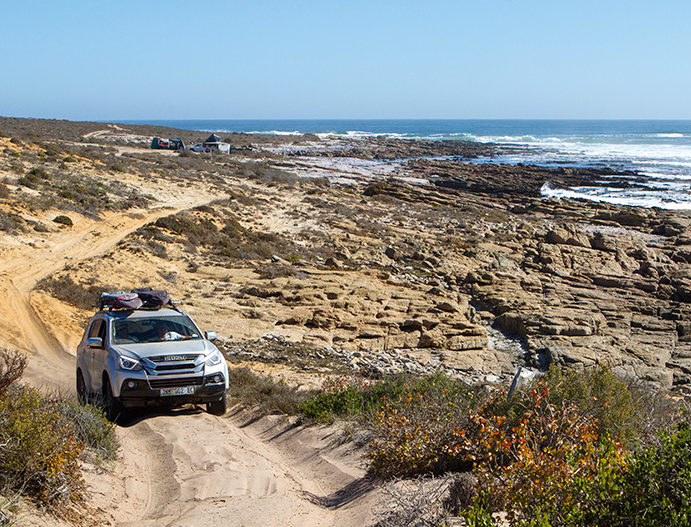

Fossilised teeth from a ‘baby’ Megalodon found by Dudley Wessels – luckily for surfers these 30-metre ancient sharks are no longer around.

Trip Planner
Getting There
Port Nolloth is 700km from Cape town, up the N7, turning onto the R382 at Steinkopf. Alexander Bay is 85km further on good tar.

Spoegrivier Caves in the Namaqua National Park were once home to Khoi herders; the nearby birdhide at the Spoegrivier estuary is well worth a look, too.
Do This
Go birding at the Ramsar site in Alexander Bay (spot the Barlow’s lark), Verlorenvlei near Elands Bay, and the Olifants River estuary.
Explore the Namaqua Coastal Route attractions of the Northern Cape.
083 364 2223, bookings @namaaquacoastal.co.za.
See the history of diamonds and more at the excellent Kleinzee Museum, and rare conophyton and other endemic plants in the Molyneux Reserve.
027 877 0028

Waves for breakfast – and possibly crayfish, too (in season) – and we didn’t have to share them with anybody else.
Book the Shipwreck Trail 4×4 adventure via Dudley Wessels. He also guides a Strandveld dune 4×4 excursion, and is your go-to guy for photo trips or adventures in the area.
083 305 2569, [email protected]
Sample the wines of the West Coast Wine Route around Lutzville. wineland.co.za
Perlemoen (abalone) and other seafood treats are on the menu at the Jetty Restaurant in Doringbaai. While there you can taste and buy the wines from Fryer’s Vineyard.
027 215 1092
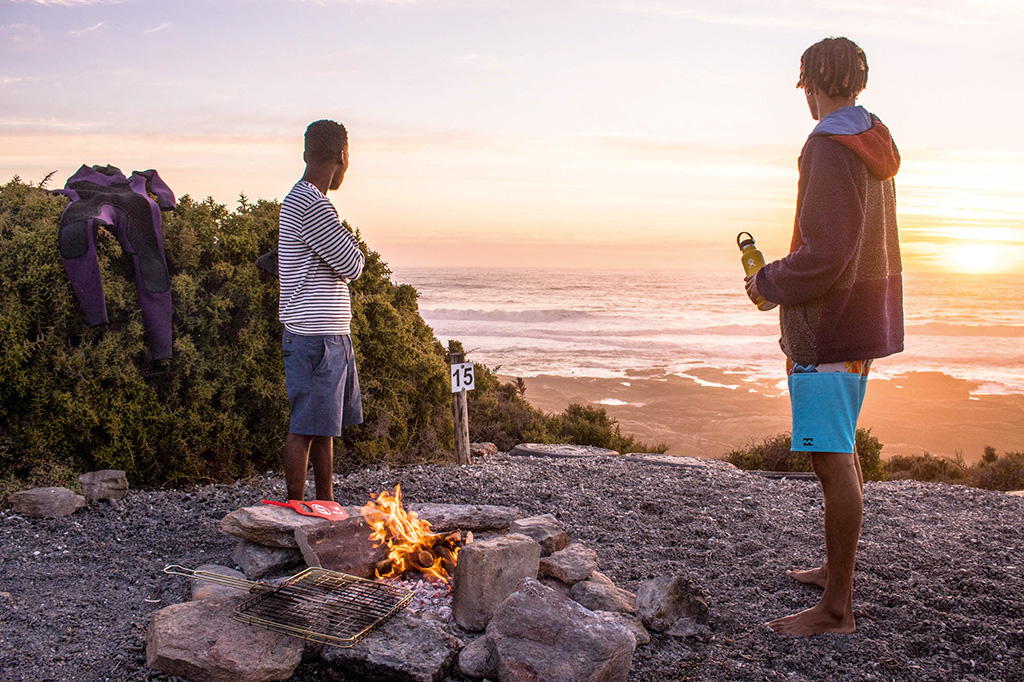
Ah, the elusive Camp 15, I presume, where it’s beer and braai time for SA surfing stars Simo Mkhize and Joshe Faulkner. (Photo Ian Thurtell)
Hike the San Trail, a 50km slackpacking route from Elands Bay to Strandfontein.
082 903 5445
Find more at experiencenortherncape.com; visitnwc.com; westcoastway.co.za
Stay Here
Alexander Bay
There is no accommodation, but it’s less than an hour’s drive from Port Nolloth. portnolloth.co.za
Kleinzee Guesthouses and wild coastal camping on the Strandveld Conservation Club’s farm, R200 pp a night for non-club members. 082 827 9723 Herman) or Jeanene on 083 364 2223
Die Houthoop has camping (R240 for two), huts (R580 for two), en suite rooms, R900 for two and family rooms, R1 050. Book the excellent dinner in advance, R180 pp; farm breakfast is R90pp.
083 967 5774, diehouthoop.co.za
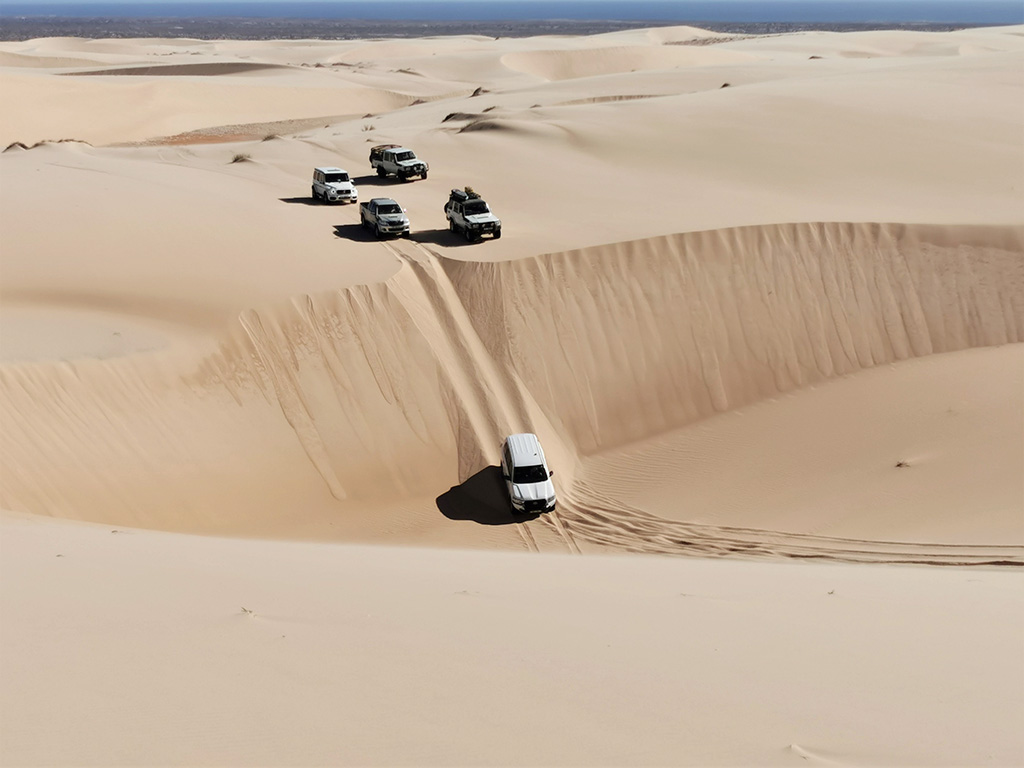
Strandveld dune adventure
Noup restored divers’ cottages that give guests access to some gated surf spots nearby. Two-, four- and six-sleeper units, from R800 for two.
079 877 8859
Honne-Pondokkies in Hondeklipbaai has camping (R350 a site, max four), Brak & Jan caravan (R550 for two), and four self-catering pondokkies (sleep four) from R750; breakfast on request.
083 321 1600, honnepondokkies.co.za
Namaqua National Park has 10 coastal campsites (nine are 4×4 only) with half-moon protective rock walls, eco-toilets and braai places, but no water. R170 a site (max six) plus R48pp daily levy. sanparks.org. South of the park, Waterval Farm has 55 coastal campsites (no facilities at all), R100 a day, 027 652 8709/WhatsApp 063 694 5092. Beyond Waterval, pitch your tent wherever you please. It’s free – return the privilege by leaving your site in pristine condition.

Honne-Pondokkies, Hondeklipbaai age
Thornbay accommodation
Has 10 self-catering apartments overlooking Doringbaai, each with a patio braai with sunset views. There’s a swimming pool, and try the on-site seafood shop for all your fish-braai desires. From R850 for two.
027 215 1333, thornbay.co.za
Protect the West Coast
Capetonian big-wave surfer Mike Schlebach loves the West Coast: ‘It’s wild, untamed and there are some serious big slabs if you’re willing to search for them,’ he says. But last year, Mike was barred from one of his usual haunts by mine security. That’s what prompted him and others to form the non-profit company Protect the West Coast (PTWC).
The primary issue is that Mineral Sands Resources (MSR), a local subsidiary of Australian mining giant Mineral Commodities Ltd (with a history of non-compliance with environ-mental laws, and controversy surrounding its bid to mine at Xolobeni on the Wild Coast), is extending their Tormin mine operations up 52km of pristine coast-line, and restricting public access to stunning wild campsites and beach breaks. Imagine the outcry if they tried that back in Australia!
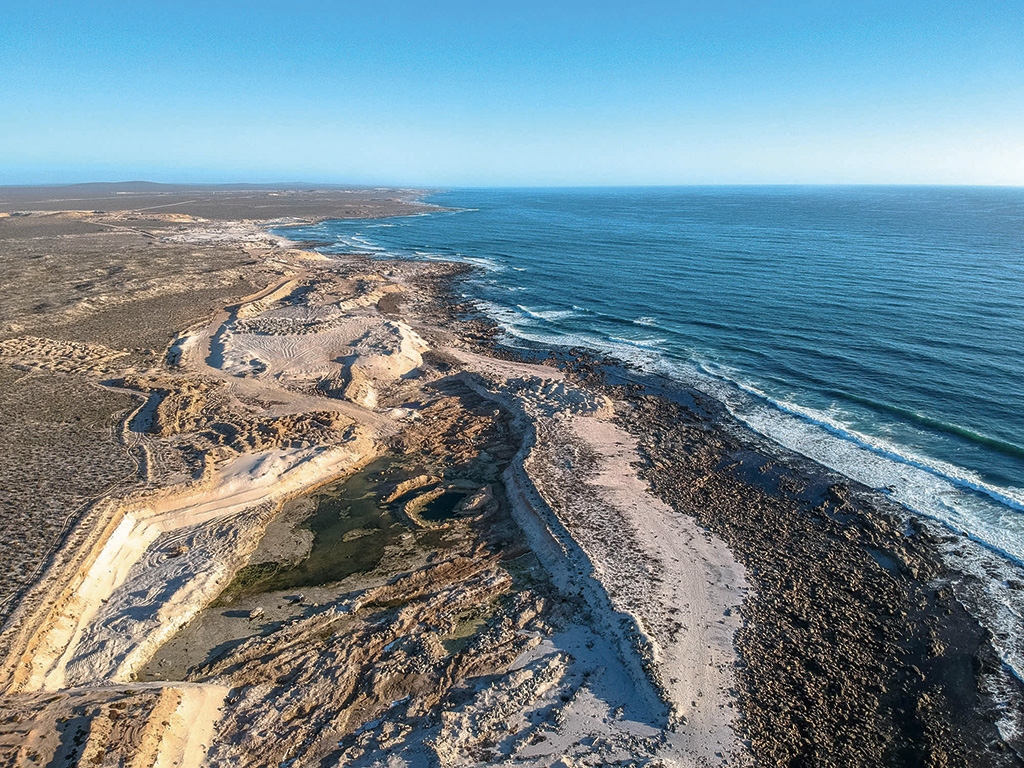
The go-ahead given by environment minister Barbara Creecy is currently being challenged in the Cape High Court by the Centre for Environmental Rights, a UCT professor and other appellants. In the meantime, MSR digs on.
‘The problem with the West Coast is that it’s out of sight and out of mind in the public eye. Mining operators get the green light for a concession, then pretty much do what they like,’ Mike says. Also worrying is the proliferation of other land as well as off-shore mining and prospecting applications for as far south as Elands Bay. Find out more at protecthewestcoast.com









